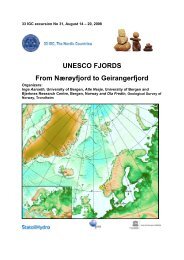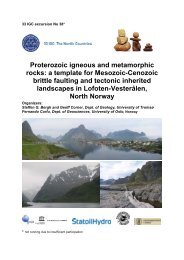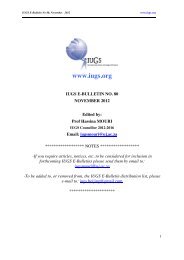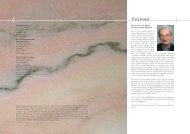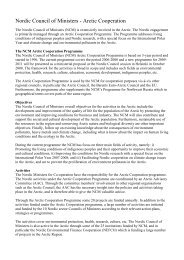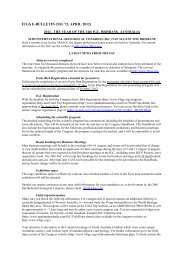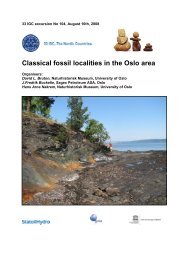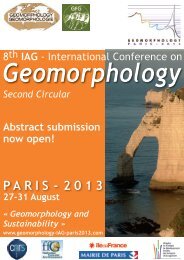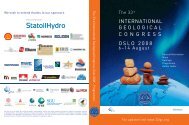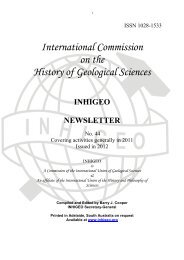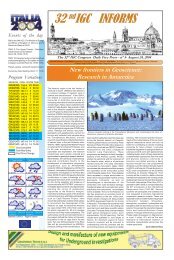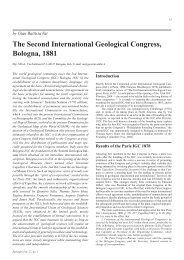Create successful ePaper yourself
Turn your PDF publications into a flip-book with our unique Google optimized e-Paper software.
At present, the timing of the stratigraphical break separated the Ponoi and Strel'na Beds is<br />
being discussed.<br />
The beginning of the early Valdaian Pleniglacial (OIS 4) was marked by a distinct cooling,<br />
which is reflected in the sediments of the glacial paragenetic association in the Chavan'ga,<br />
Kamenka, and Bol'shaya Kumzhevaya sections (Fig. 4.2A). According to the available<br />
regional stratigraphic scheme, these sediments correspond to the Podporozh'e glacial horizon.<br />
Norwegian scientists (Lauritzen, 1995) established the existence of ice-free environments<br />
150-71 ka in the immediate vicinity of the Scandinavian glaciation center. According to<br />
computer-based modeling data of Swedish and American researchers, the eastern part of the<br />
Kola Peninsula was free of ice of the Scandinavian center until approximately 70 ka (Naslund<br />
et al., 2003). The formation of the Podporozh'e glacial horizon in the Terskii Coast of the<br />
White Sea was likely related to the development of the Kara glacier rather than the<br />
Scandinavian glacier, in this area during the early Pleniglacial (OIS 4). This assumption is<br />
indirectly supported by findings of carbonate rock pebbles and boulders that are unknown in<br />
the Kola Peninsula but typical of Paleozoic rocks in the northern Russian Platform.<br />
The Podporozh'e Horizon is overlain by the third marine sequence of interglacial origin<br />
(according to our geological data and subfossils therein (Grave et al, 1969, Gudina, Evzerov,<br />
1973)). The available geochronological data (Korsakova et al., 2004) point to its Middle<br />
Pleniglacial age (OIS 3). The sequence (sands, sandy loams, and loams) is overlain by marine<br />
or glaciomarine sediments (Fig. 6.2A) and correlated with the Leningrad Horizon (Fig. 6.2B).<br />
Thus, it is established that the geological-stratigraphic position of the Upper Pleistocene<br />
marine sediments in the southern Kola Peninsula was determined by the development of at<br />
least three transgressions. The last transgression predated the early Pleniglacial (OIS 4)<br />
continental glaciation. Geochronological data indicate the Mikulinian age of the first<br />
transgression, which correlates with the Boreal transgression in the northern East European<br />
Plain. This is indicated by the presence of the Ponoi marine beds (Fig. 4.2B). The second<br />
transgression, which correlates with the Strel'na marine beds, has an early Valdaian age (Fig.<br />
6.2B). The marine environment was interrupted by glaciation (OIS 4) in the southern Kola<br />
Peninsula, and the late Pleistocene transgression III 60-40 ka was referred to the middle<br />
Pleniglacial (OIS 3). The relevant marine sediments (Leningrad Horizon) are everywhere<br />
overlain by the Late Valdaian glacial sediments that make up the Ostashkovian Horizon (Fig.<br />
6.2B).<br />
Stop 11. Varzuga section of the Upper Pleistocene marine sediments<br />
The Varzuga outcrop (Fig. 4.3, 4.4) located on the south coast of the Kola Peninsula at about<br />
66.4°N and 36.6°E on the right bank of the Varzuga River where in the c. 700-m-long area<br />
upstream of the Kojtugov and Kletnoy rapids several exposures over 30 m high occur.<br />
48



